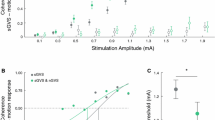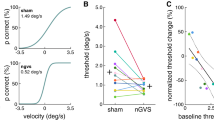Abstract
Patients with bilateral vestibulopathy (BVP) suffer from persistent imbalance during standing and walking as well as an impaired gaze stabilization during head movements. Disabilities associated with BVP severely compromise patients’ daily activities and are often linked to an increased risk of falls. Currently, the only established treatment option in BVP is physical therapy. However, treatment effects of physical therapy in BVP are most often limited and many patients do not adequately recover performance. Therefore, a number of technical therapeutic approaches are being explored that either try to substitute lost vestibular sensation with a congruent stimulation of other sense modalities or to artificially mimic vestibular function by means of an implantable vestibular prosthesis. Besides, attempts have recently been made to augment and optimize residual vestibular function in patients with BVP using an imperceptible noisy galvanic vestibular stimulation (nGVS). This approach is based on the natural phenomenon of stochastic resonance, wherein the signal processing in sensory systems can be improved by adding an appropriate level of noise to the system. Promising first study outcomes of nGVS treatment in patients with BVP indicate the feasibility of a future non-invasive sensory prosthetic device for BVP rehabilitation. This paper gives an overview about recent research on nGVS treatment in patients with BVP and discusses future research perspectives in this field.

Similar content being viewed by others
References
Brandt T, Huppert T, Hufner K, Zingler VC, Dieterich M, Strupp M (2010) Long-term course and relapses of vestibular and balance disorders. Restor Neurol Neurosci 28:69–82
Brandt T, Strupp M, Benson J (1999) You are better off running than walking with acute vestibulopathy. Lancet 354:746
Collins J, Chow CC, Imhoff TT (1995) Stochastic resonance without tuning. Nature 376:236–238
Dakin CJ, Inglis JT, Chua R, Blouin JS (2013) Muscle-specific modulation of vestibular reflexes with increased locomotor velocity and cadence. J Neurophysiol 110:86–94
Dozza M, Chiari L, Horak FB (2005) Audio-biofeedback improves balance in patients with bilateral vestibular loss. Arch Phys Med Rehabil 86:1401–1403
Fitzpatrick RC, Day BL (2004) Probing the human vestibular system with galvanic stimulation. J Appl Physiol (1985) 96:2301–2316
Fitzpatrick RC, Wardman DL, Taylor JL (1999) Effects of galvanic vestibular stimulation during human walking. J Physiol 517(Pt 3):931–939
Fujimoto C, Yamamoto Y, Kamogashira T, Kinoshita M, Egami N, Uemura Y, Togo F, Yamasoba T, Iwasaki S (2016) Noisy galvanic vestibular stimulation induces a sustained improvement in body balance in elderly adults. Sci Rep 6:37575
Gensberger KD, Kaufmann AK, Dietrich H, Branoner F, Banchi R, Chagnaud BP, Straka H (2016) Galvanic vestibular stimulation: cellular substrates and response patterns of neurons in the vestibulo-ocular network. J Neurosci 36:9097–9110
Gillespie MB, Minor LB (1999) Prognosis in bilateral vestibular hypofunction. Laryngoscope 109:35–41
Goodworth AD, Wall C 3rd, Peterka RJ (2009) Influence of feedback parameters on performance of a vibrotactile balance prosthesis. IEEE Trans Neural Syst Rehabil Eng 17:397–408
Guyot JP, Perez Fornos A, Guinand N, van de Berg R, Stokroos R, Kingma H (2016) Vestibular assistance systems: promises and challenges. J Neurol 263(Suppl 1):S30–S35
Herdman SJ, Hall CD, Maloney B, Knight S, Ebert M, Lowe J (2015) Variables associated with outcome in patients with bilateral vestibular hypofunction: preliminary study. J Vestib Res 25:185–194
Herdman SJ, Hall CD, Schubert MC, Das VE, Tusa RJ (2007) Recovery of dynamic visual acuity in bilateral vestibular hypofunction. Arch Otolaryngol Head Neck Surg 133:383–389
Iwasaki S, Karino S, Kamogashira T, Togo F, Fujimoto C, Yamamoto Y, Yamasoba T (2017) Effect of noisy galvanic vestibular stimulation on ocular vestibular-evoked myogenic potentials to bone-conducted vibration. Front Neurol 8:26
Iwasaki S, Yamamoto Y, Togo F, Kinoshita M, Yoshifuji Y, Fujimoto C, Yamasoba T (2014) Noisy vestibular stimulation improves body balance in bilateral vestibulopathy. Neurology 82:969–975
Jaramillo F, Wiesenfeld K (1998) Mechanoelectrical transduction assisted by Brownian motion: a role for noise in the auditory system. Nat Neurosci 1:384–388
Kim DJ, Yogendrakumar V, Chiang J, Ty E, Wang ZJ, McKeown MJ (2013) Noisy galvanic vestibular stimulation modulates the amplitude of EEG synchrony patterns. PLoS One 8:e69055
Krebs DE, Gill-Body KM, Riley PO, Parker SW (1993) Double-blind, placebo-controlled trial of rehabilitation for bilateral vestibular hypofunction: preliminary report. Otolaryngol Head Neck Surg 109:735–741
Lewis RF (2016) Vestibular implants studied in animal models: clinical and scientific implications. J Neurophysiol 116:2777–2788
McDonnell MD, Ward LM (2011) The benefits of noise in neural systems: bridging theory and experiment. Nat Rev Neurosci 12:415–426
Mergner T, Schweigart G, Fennell L, Maurer C (2009) Posture control in vestibular-loss patients. Ann N Y Acad Sci 1164:206–215
Moss F, Ward LM, Sannita WG (2004) Stochastic resonance and sensory information processing: a tutorial and review of application. Clin Neurophysiol 115:267–281
Mulavara AP, Fiedler MJ, Kofman IS, Wood SJ, Serrador JM, Peters B, Cohen HS, Reschke MF, Bloomberg JJ (2011) Improving balance function using vestibular stochastic resonance: optimizing stimulus characteristics. Exp Brain Res 210:303–312
Mulavara AP, Kofman IS, De Dios YE, Miller C, Peters BT, Goel R, Galvan-Garza R, Bloomberg JJ (2015) Using low levels of stochastic vestibular stimulation to improve locomotor stability. Front Syst Neurosci 9:117
Nadrowski B, Martin P, Julicher F (2004) Active hair-bundle motility harnesses noise to operate near an optimum of mechanosensitivity. Proc Natl Acad Sci USA 101:12195–12200
Pozzo T, Berthoz A, Vitte E, Lefort L (1991) Head stabilization during locomotion. Perturbations induced by vestibular disorders. Acta Otolaryngol Suppl 481:322–327
Priplata AA, Niemi JB, Harry JD, Lipsitz LA, Collins JJ (2003) Vibrating insoles and balance control in elderly people. Lancet 362:1123–1124
Sadeghi SG, Chacron MJ, Taylor MC, Cullen KE (2007) Neural variability, detection thresholds, and information transmission in the vestibular system. J Neurosci 27:771–781
Schniepp R, Schlick C, Schenkel F, Pradhan C, Jahn K, Brandt T, Wuehr M (2017) Clinical and neurophysiological risk factors for falls in patients with bilateral vestibulopathy. J Neurol 264:277–283
Serrador JM, Geraghty MC, Deegan BM, Wood SJ (2011) Enhancing vestibular function by imperceptible electrical stimulation. J Vestib Res 21:101–103
Wall C 3rd, Weinberg MS, Schmidt PB, Krebs DE (2001) Balance prosthesis based on micromechanical sensors using vibrotactile feedback of tilt. IEEE Trans Biomed Eng 48:1153–1161
Wilkinson D, Zubko O, Sakel M (2009) Safety of repeated sessions of galvanic vestibular stimulation following stroke: a single-case study. Brain Inj 23:841–845
Wuehr M, Nusser E, Decker J, Krafczyk S, Straube A, Brandt T, Jahn K, Schniepp R (2016) Noisy vestibular stimulation improves dynamic walking stability in bilateral vestibulopathy. Neurology 86:2196–2202
Wuehr M, Nusser E, Krafczyk S, Straube A, Brandt T, Jahn K, Schniepp R (2016) Noise-enhanced vestibular input improves dynamic walking stability in healthy subjects. Brain Stimul 9:109–116
Wuehr M, Pradhan C, Brandt T, Jahn K, Schniepp R (2014) Patterns of optimization in single- and inter-leg gait dynamics. Gait Posture 39:733–738
Zingler VC, Weintz E, Jahn K, Mike A, Huppert D, Rettinger N, Brandt T, Strupp M (2008) Follow-up of vestibular function in bilateral vestibulopathy. J Neurol Neurosurg Psychiatry 79:284–288
Acknowledgements
The authors thank Haike Dietrich for copy-editing the manuscript. The work was supported by the Federal Ministry for Education and Science (BMBF, Nr. 80121000-49) of Germany.
Author information
Authors and Affiliations
Corresponding author
Ethics declarations
Conflicts of interest
Max Wuehr, Julian Decker, and Roman Schniepp declare that there are no financial disclosures or conflicts of interest.
Ethical standards
The content of this review complied with all ethical standards.
Additional information
This manuscript is part of a supplement sponsored by the German Federal Ministry of Education and Research within the funding initiative for integrated research and treatment centers.
Rights and permissions
About this article
Cite this article
Wuehr, M., Decker, J. & Schniepp, R. Noisy galvanic vestibular stimulation: an emerging treatment option for bilateral vestibulopathy. J Neurol 264 (Suppl 1), 81–86 (2017). https://doi.org/10.1007/s00415-017-8481-4
Received:
Revised:
Accepted:
Published:
Issue Date:
DOI: https://doi.org/10.1007/s00415-017-8481-4




